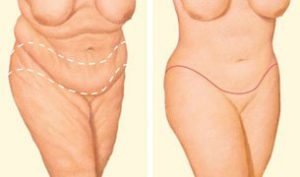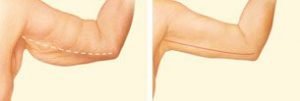Body Contouring After Weight Loss in Scottsdale
Removes excess sagging fat and skin while improving the shape of the underlying support tissue
Surgical body contouring following major weight loss removes excess sagging fat and skin while improving the shape of the underlying support tissue. The result is a more normal appearance with smoother contours.
Dramatic weight loss has many benefits. But after weight reduction surgery, or any substantial amount of weight loss, the skin and tissues often lack the elasticity to conform to the reduced body size.
Body contouring procedures may include: 
- Facelift: sagging of the mid-face, jowls, and neck
- Breast lift: sagging, flattened breasts
- Tummy tuck: apron of excess skin hanging over the abdomen
- Lower body lifts: sagging of the abdomen, buttocks, groin and outer thighs
- Medial thigh lift: sagging of the inner, outer and mid-thigh
- Arm lift: sagging of the upper arms
Body Contouring Cost
The average cost of body contouring surgery can vary widely. A surgeon’s cost for body contouring procedures may vary based on his or her experience, the type of procedure(s) used, as well as geographic office location. Health insurance plans usually do not cover body contouring surgery or its complications, but Dr. Bash offers several patient financing plans, so be sure to ask.
Body contouring surgery cost may include:
- Anesthesia fees
- Hospital or surgical facility costs (Dr. Bash operates at Piper Center, part of Scottsdale on Shea Honor Health system)
- Medical tests, such as blood work and EKG
- Post-surgery garments
- Prescriptions for medication Surgeon’s fee
Body Contouring Candidates
In general, good body contouring candidates are:
- Adults whose weight loss has stabilized
- Healthy individuals without medical conditions that impair healing or increase risk of surgery
- Non-smokers
- Individuals with a positive outlook and realistic goals
- Individuals that are committed to leading a healthy lifestyle with proper nutrition and fitness
Body Contouring Recovery
During your recovery from body contouring surgery, dressings or bandages will be applied to your incisions following the procedure.
Small, thin tubes (drains) may be temporarily placed under the skin to drain any excess blood or fluid that may collect. You will be given specific instructions that may include how to care for the surgical site(s), medications to apply or take orally to aid healing and reduce the potential for infection, specific concerns to look for at the surgical site or in your general health, and when to follow up with your plastic surgeon. You may be instructed to avoid bending, straining or lifting for several days to weeks.
Where tightening of the abdomen or thighs is involved, your plastic surgeon may also instruct you to avoid standing fully upright and stressing any internal sutures as they heal, and to sleep with pillows elevating your knees.
To minimize the risk of DVT (blood clots in the legs) you will need to be up and walking as soon as possible, and drinking plenty of fluid. Some patients may be placed on a blood thinner medication following surgery. Dr. Bash will discuss this with you at your consultation appointment.
Follow all instructions carefully – this is essential to the success of your outcome.
You’ll need help. If a component of your body contouring surgery is performed on an outpatient basis, be sure to arrange for someone to drive you to and from surgery and to stay with you for at least the first night following surgery.
Be sure to ask Dr. Bash specific questions about what you can expect during your individual recovery period:
- Where will I be taken after my surgery is complete?
- What medication will I be given or prescribed after surgery?
- Will I have dressings/bandages after surgery? When will they be removed?
- Are stitches removed? When?
- When can I resume normal activity and exercise?
- When do I return for follow-up care?
Body Contouring before and after results
- The results of body contouring following aggressive weight loss are visible almost immediately; however, it can take two years or more to see the final results.
- Visible scars are something you must accept in your goals to achieving a body contour that matches your new weight and proportion.
- The results of body contouring are generally long lasting, provided that you maintain a stable weight and general fitness. As your body ages, it is natural to lose some firmness. However, most of your initial improvement should be relatively permanent.
- Although good results are expected from your procedure, there is no guarantee. In some situations, it may not be possible to achieve optimal results with a single surgical procedure and another surgery may be necessary.
- Following your physician’s instructions is critical to the success of your surgery.
- It is important that the surgical incisions are not subjected to excessive force, swelling, abrasion, or motion during the time of healing. Your doctor will give you specific instructions on how to care for yourself.
Body contouring procedure steps
The procedures necessary to achieve your goals will be defined along with a plan for the timing of these procedures.
Plastic surgery procedures that may be recommended by your physician include:
- Lower body lift: to correct sagging of the abdomen, buttocks, groin and outer thighs
- Breast lift: to correct sagging, flattened breasts • Arm lift: to correct sagging of the upper arms
- Thigh lift: to correct sagging of the inner, outer and mid-thigh
Step 1 - Anesthesia
Medications are administered for your comfort during the surgical procedures. The choices include intravenous sedation and general anesthesia. Your doctor will recommend the best choice for you.
Step 2 - The incision
All body contouring procedures require large incisions to remove excess skin. In many cases, these incisions may be extensive.
Incision length and pattern depend on the amount and location of excess skin to be removed, as well as personal preference and your doctor’s surgical judgment. Advanced techniques usually allow incisions to be placed in strategic locations where they can be hidden by most types of clothing, but this is not always the case.
Body contouring is often performed in stages. Your particular condition and goals, as well as your plastic surgeon’s best judgment, will all influence how your doctor defines a surgical plan.
While it may have taken you two years or more to lose all the excess weight, it may take equally as long for the results of your body contouring to be complete.
Body Lift
A complete lower body lift treats sagging buttocks, abdomen, waist, hips and outer thighs in one procedure. Incision patterns vary, and may include a circumferential incision around the body to remove the “belt” of excess skin and fat.

Breast Lift
The incision patterns for lifting a woman’s sagging breasts will be determined based on the amount of excess skin to be removed. These may include one or a combination of incisions in a circular pattern around the areola, in a line extending from the areola to the breast crease, and horizontally along the breast crease. A breast implant also may be recommended to enhance breast shape and size.

Arm Lift
Sagging skin in the upper arms is treated with an incision from the underarm area extending along the inside or back of the upper arm. Additional incisions on the arms may be necessary anywhere excess skin has formed sagging pockets. The smoother, tighter contours that result from upper arm contouring are apparent almost immediately, although initially obscured by swelling and bruising. The ultimate scar will be more obvious when the arms are raised.

Thigh Lift
Reshaping of the thighs is achieved through incisions in the groin that can extend downward to the knee along the inner portion of the thigh. Improving contours of the outer thigh may require an incision extending from the groin around the hip. Through these incisions your plastic surgeon will tighten tissues for a smoother, thigh.
Body contouring procedure steps
The decision to have plastic surgery is extremely personal, and you will have to decide if the benefits will achieve your goals and if the risks and potential complications of body contouring surgery are acceptable.
You will be asked to sign consent forms to ensure that you fully understand the procedure and any risks and potential complications. Body contouring risks include:
- Bleeding Infection
- Fluid accumulation
- Poor wound healing
- Skin loss
- Blood clots, deep vein thrombosis (DVT) and pulmonary embolism
- Excessive or widened scars • Numbness or other changes in skin sensation
- Anesthesia risks
- Unfavorable scarring
- Residual skin laxity or contour irregularity
These risks and others will be fully discussed prior to your consent. It is important that you address all your questions directly with Dr. Bash.
Your body contouring consultation
During your body contouring consultation be prepared to discuss:
- Why you want the surgery, your expectations and desired outcome
- Medical conditions, drug allergies and previous medical treatments
- Current medications, vitamins, herbal supplements, alcohol, tobacco and drug use
- Previous surgeries
Dr. Bash will:
- Evaluate your general health and any preexisting health conditions or risk factors
- Examine your body and take detailed measurements
- Take photographs for your medical record
- Discuss your options and recommend a course of treatment
- Discuss likely outcomes of body contouring and any risks or potential complications
It’s very important to understand all aspects of your body contouring procedure. It’s natural to feel some anxiety, whether it’s excitement for your anticipated new look or a bit of preoperative stress. Don’t be shy about discussing any concerns with your plastic surgeon.
Body contouring words to know
- Areola: Pigmented skin surrounding the nipple.
- Arm lift: A surgical procedure, also known as brachioplasty, to correct sagging of the upper arms.
- Breast implants: Medical device placed in your body to enhance an existing breast size or to reconstruct your breast. Breast implants can be filled with either salt water (saline) or silicone (elastic gel).
- Breast lift: Also known as mastopexy, surgery to lift the breasts.
- Breast contouring: A surgical procedure following massive weight loss to improve shape and tone and remove excess fat and skin.
- Circumferential incision: A surgical incision around the body to remove the “belt” of excess skin and fat and additional incisions that may resemble a bikini bottom pattern.
- General anesthesia: Drugs and/or gases used during an operation to relieve pain and alter consciousness.
- Hematoma: Blood pooling beneath the skin.
- Intravenous sedation: Sedatives administered by injection into a vein to help you relax.
- Local anesthesia: A drug injected directly to the site of an incision during an operation to relieve pain.
- Lower body lift: Surgical procedure to correct sagging of the abdomen, buttocks, groin and outer thighs.
- Macerated skin: Excess skin that hangs and becomes wet or infected underneath.
- Medial thigh lift: A surgical procedure to correct sagging of the inner thigh.
- Outer thigh lift: A surgical procedure to correct sagging of the outer and mid-thigh.
- Sutures: Stitches used by surgeons to hold skin and tissue together.
Questions to ask Dr. Bash or any plastic surgeon.
Use this checklist as a guide during your body contouring consultation:
- Are you certified by the American Board of Plastic Surgery?
- Were you trained specifically in the field of plastic surgery?
- How many years of plastic surgery training have you had?
- Do you have hospital privileges to perform this procedure? If so, at which hospitals?
- Is the office-based surgical facility accredited by a nationally- or state-recognized accrediting agency, or is it state-licensed or Medicare-certified?
- Am I a good candidate for this procedure?
- What will be expected of me to get the best results?
- Where and how will you perform my procedure?
- What surgical technique is recommended for me?
- How long of a recovery period can I expect, and what kind of help will I need during my recovery?
- What are the risks and complications associated with my procedure?
- How are complications handled?
- How can I expect to look over time? After pregnancy?
- What are my options if I am dissatisfied with the cosmetic outcome of my procedure?
- Do you have before-and-after photos I can look at for this procedure and what results are reasonable for me?
Choose a body contouring surgeon you can trust
Body contouring surgery involves many choices. The first and most important is selecting a member of the American Society of Plastic Surgeons (ASPS) surgeon you can trust. Dr. Bash has been a member since 1994, and is board certified by the American Board of Plastic Surgery.
- ASPS member surgeons meet rigorous standards:
- Board certification by the American Board of Plastic Surgery® (ABPS)
- Complete at least six years of surgical training following medical school with a minimum of three years of plastic surgery residency training
- Pass comprehensive oral and written exams
- Graduate from an accredited medical school
- Complete continuing medical education, including patient safety, each year
- Perform surgery in accredited, state-licensed, or Medicare-certified surgical facilities
Do not be confused by other official sounding boards and certifications.
The ABPS is recognized by the American Board of Medical Specialties (ABMS), which has approved medical specialty boards since 1934. There is no ABMS recognized certifying board with “cosmetic surgery” in its name.
By choosing a member of the American Society of Plastic Surgeons, you can be assured that you are choosing a qualified, highly trained plastic surgeon who is board-certified by the ABPS
